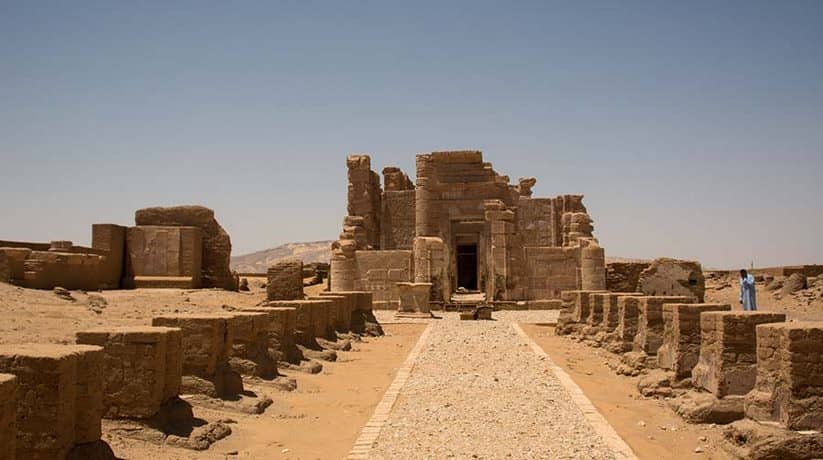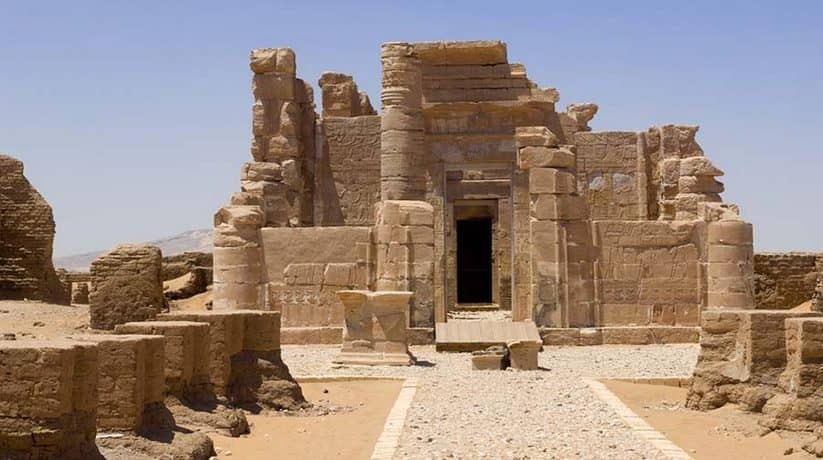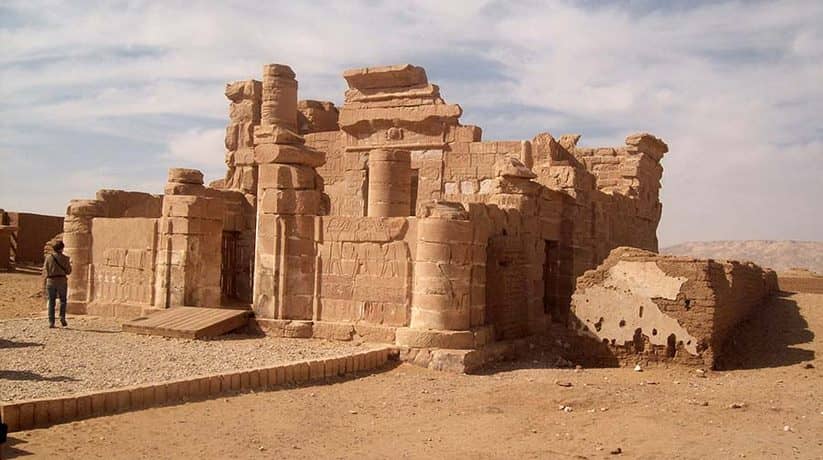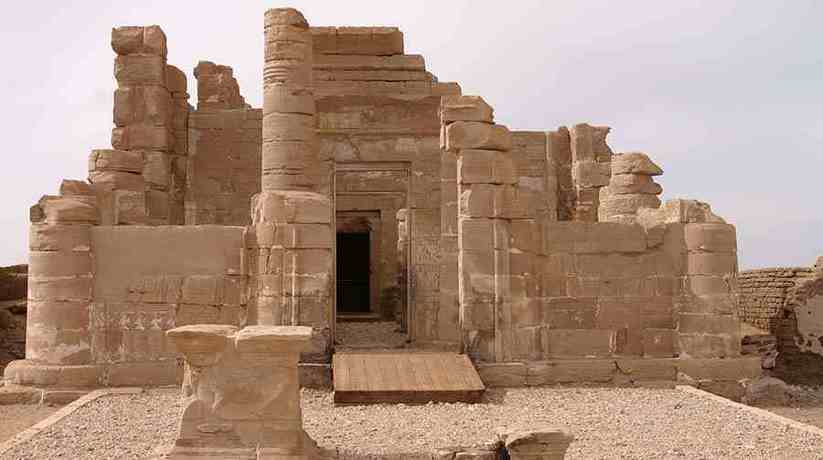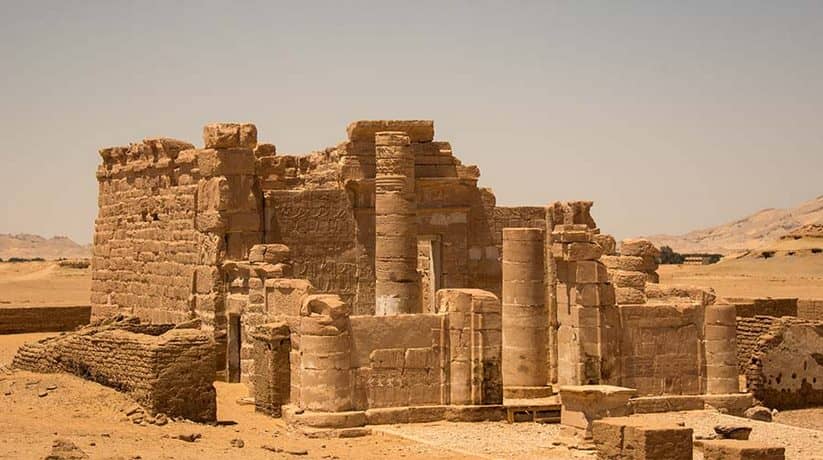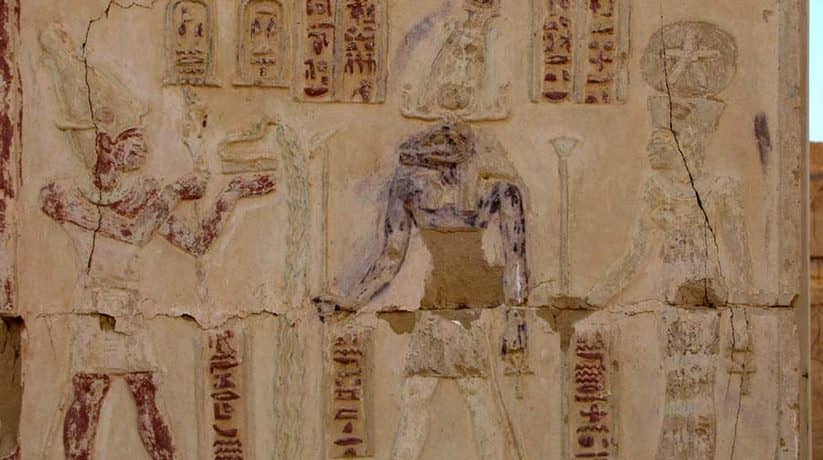Deir El Hagar temple Dakhla Oasis tours, booking, prices, reviews
Deir El Hagar temple is a sandstone temple which located on the western edge of Dakhla Oasis, Egypt. Moreover, the temple is just 10 kilometers from Al Qasr. Furthermore, Deir El Hagar temple located in the desert to the south of the cultivation. In fact, the temple known as “Place of Coming Home” or “Set-whe” in Ancient times. Furthermore, the temple buried in debris and sand for many centuries. In fact, it was by the huge dune which can still seen to the south. Recently, the temple uncovered, restored and reconstructed during the 1990. It was by the Dakhla Oasis Project with the Supreme Council of Antiquities and is now open to visitors. The temple represents one of the most complete Roman monuments in Dakhla Oasis.
The isolated site was a festival temple rather than a cult temple. The cult temple more usually found in the center of a community. In fact, Deir El Hagar temple Dakhla Oasis dedicated to the Theban Triad and to Thoth. The construction of the temple began during the reign of the Roman Emperor Nero 54-68 AC. In fact, the cartouche of Nero can seen in the sanctuary. Furthermore, the temple built to encourage farmers to settle in the area. It is along with irrigation works, villages and the mud-brick Roman farmsteads. In fact, they still seen in the area which surrounds the temple. Nero’s successor Vespasian 69-79 AC added decoration to the sanctuary. And then, Titus (79-81 AC) added the porch.
Further details about Deir El Hagar temple:
Finally Domitian (81-96 AC) decorated some of the doorways and the monumental gateway. Moreover, other Roman rulers contributed to the decoration. In fact, it was with the latest inscription in the temple which dates back to the 3rd century AC. Deir El Hagar temple building measures 7.3 meter by 16.2 meter. Moreover, the temple has a well-preserved outer mud-brick enclosure wall. It is where some remains of painted plaster still seen. The main gateway located in the eastern side of the enclosure wall. Moreover, there is another gateway to the south, in the temenos wall of the sanctuary. In fact, the gateway depicts many Greek inscriptions and graffito. They written by early travelers who wanted to record their visits to this sacred place.
During the 19th century, travelers began to visit Deir El Hagar temple. In fact, many of the visitors left their names incised high on the columns and walls of the porch. Moreover, an sign of the level of sand fill at that time. On a column in the columned hall, are the incised names of the ill-fated expedition. In fact, the expedition led by Gerhardt Rohlfs in January 1874. This expedition traveled to the west of Dakhla into the Great Sand Sea. In fact, they did not expect the size and extent of the huge sand dunes. After three days, they had to turn back and take a another route to Siwa Oasis. In 1874 Remale also cleared sand from the sanctuary. In 1908 Winlock published the first extensive description of the temple.
More details about Deir El Hagar temple Dakhla Oasis:
Moreover, during the 1960s, Ahmed Fakhry excavated in front of the porch. There is a processional way which leads from the main gateway up to the temple entrance. In fact, it still has remains of round mud-brick columns. The remains were part of pillared halls and flank the entrance. Moreover, a few small sphinxes found in this area can now seen in the Kharga Heritage Museum. The entrance to the temple is through a screen wall into the wide pronaos or porch which has two columns. A doorway leads to a small hypo-style hall containing four columns. The doorway in turn opens into a hall of offerings before the central sanctuary. The sanctuary flanked by two side-chambers. Furthermore, to the south is the staircase which gave access to the roof.
To the north, there is a storage chamber. The sanctuary itself decorated with a magnificent astronomical ceiling. In fact, it dates back to the rule of Hadrian (117-138 AC). Moreover, it painted reliefs including an arching figure of the goddess Nut. The figure represents the sky and the god Geb who symbolizes the earth. In the center of the ceiling, the god Osiris represented by the constellation of Orion. The other astronomical features represented by various deities. In fact, their task was to maintain the universe. Also depicted on the ceiling is a representation in the form of a sphinx, of the god Tutu. The fallen zodiac ceiling from the sanctuary re- assembled. In fact, it was for viewing outside the temple building. Such a scene is unique in temple sanctuary decoration.
Further details about Deir El Hagar temple Dakhla Oasis:
The west wall at the rear of the sanctuary gives prominence to the primary gods of the temple. In fact, the gods are Amun-Re and Mut. The south wall portrays the Theban Triad of Amun-Re, Mut and Khons. Moreover, it also portrays Seth, Nephthys, Re-Horakhty, Osiris and Isis, and Min-Re. The northern wall includes the Theban Triad. In fact, it is alongside the Heliopolitan creator gods, Geb, Nut, Shu and Tefnut. Here also is an important representation of the Dakhla god Amun-Nakht. Furthermore, there is an inscription from the sanctuary. In fact, the inscription denotes his earliest known visit to the oasis.
This desert god, shown at Deir El Hagar temple with his consort Hathor. Thoth is another deity which well represented in the oases. In fact, Thoth also seen with his local consort Nehmetaway. Remains of other still partly-buried structures surround the temple. Moreover, there is a block field to the west of the enclosure. In the immediate vicinity, there is much evidence of agriculture in Roman times. In fact, it included pigeon-houses. To the north-west of the temple is a Roman Period cemetery. In fact, it is where crude human-headed terracotta coffins uncovered.

